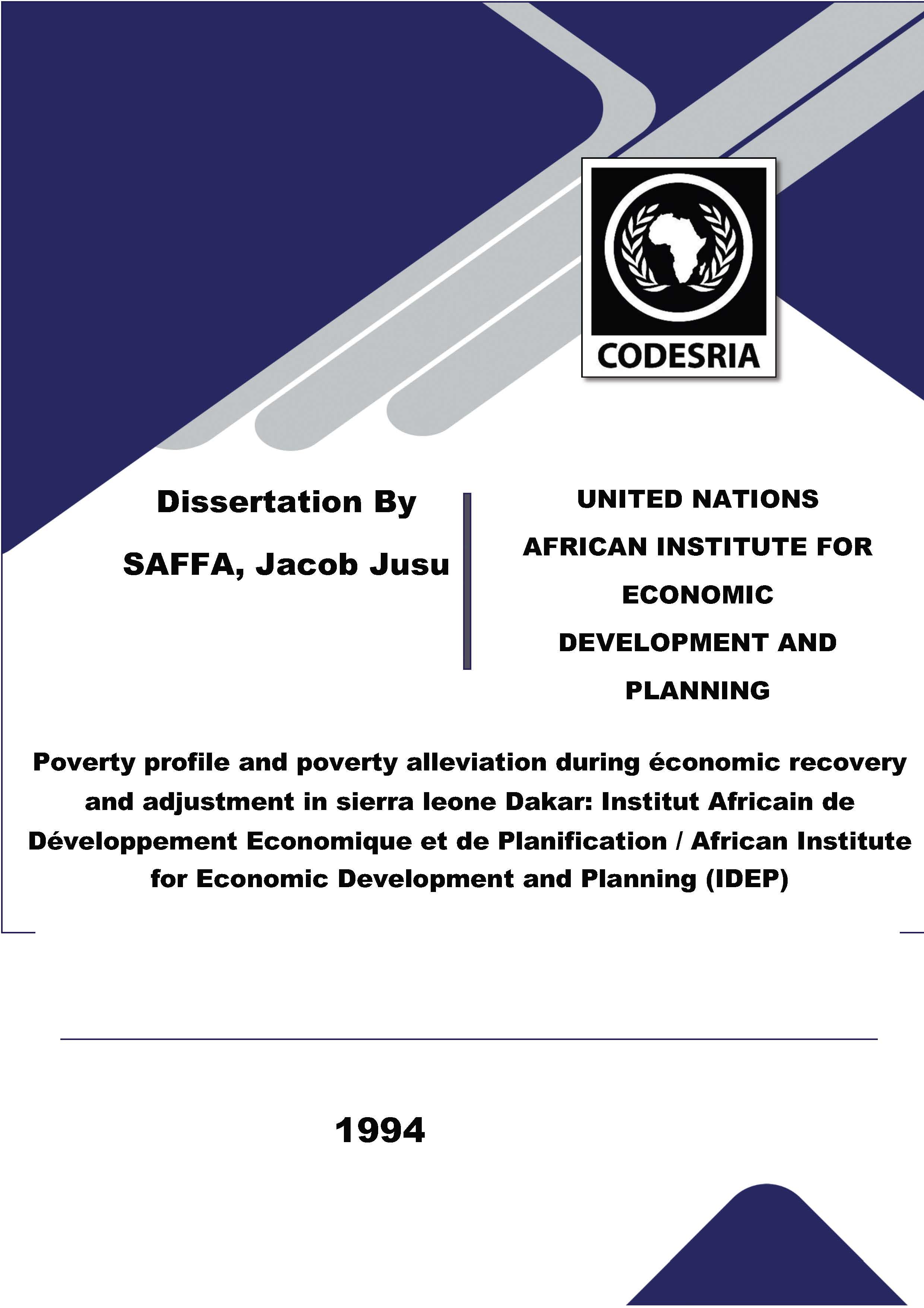Poverty profile and poverty alleviation during économic recovery and adjustment in sierra leone Dakar: Institut Africain de Développement Economique et de Planification / African Institute for Economic Development and Planning (IDEP)
Synopsis
The Government of Sierra Leone (GOSL) initiated the IMF/World
Bank i nsp i red Structural Adj ustment Programme (SAP) in .1 986 to
redress the macroeconomic imbalances and structural bottlenecks
that characteri sed the Si erra Leonean economy from the 1970s
through the 1980s. Notwithstanding, the macroeconomic imbalances
and the structural
hardshi p for the
bottlenecks continue and there is increased
vast majori ty of the population. The common
contention is that the number of the poor and the sev1;Jrity of
poverty increased during the recovery and adjustment period.
This study therefore tested the hypothesis that poverty became
widespread during the policy reform period (1986 to date).
Accordingly, the specific objectives considered include:
determining the number of the poor, who they are and where they
live, why they are poor and how they cope. This was followed by a
proposal on a new agenda for poverty alleviation. Bath empirical
and analytical approaches wer~ adopted to achieve the objectives.
The study utilised survey reports, data generated by Wo~ld Bank,
UNICEF, Government departments and other agencies.
It was found that the number of the poor and the severity of
poverty increased during the reform period. It was also shown that
poverty is more widespread in rural areas than the urban areas and
the North and the South are worse off than the West and the East.
The causes of widespread poverty include: prevailing macrdeconomic
imbalances, the disjointed and selective SAP initiated in 1986,
population increase, environmental degradation, unemployment,
underemployment and low labour productivity.
Téléchargements
Références
ADB/UNDP/World Bank (1990). "The Social Dimensions of Adjustment ,n AIT1ca: A policy agenda".
Ahmed et. al. (1992). "Poverty in the Gambia''. An ILO/FAO/UNDP study.
Baffoe, .J.k. (1992). "Incarne Distr.ibution and. Poverty Profile 1n Ghana 1987-88". AFrica Development Review, Vol.4, No. 1. June, pp. 1-28.
Barlay-, K.L. (1992). "Sierra Leone: Structural Adjustment and ·Social. Sector issues and Poverty" (unpublished consultancy). ·
Behram, .J.R. and Deolaliker A.B. (1991). "The Poor and the Social sectors during a period of macroeconomic adjustment: Empirical ev1dence for Jarnaica". The World Bank Economie Review Vol .5 No.2, pp.297-312.
Bhalla, A.S. ed. (1992). "Environment, Employment and Development··. ILO, Geneva.
Boateng, E.O. et. al. (1990). "A Poverty Profile for Ghana (1987-88)'·Social Dimensions of Adjustment (SDA) in sub-Saharan Afr1ca, WorKing Paper No.5, Policy Analysis, World Bank, Washington, D.C.
Commonwealth Secretariat (1991). "Crushing Rural Poverty". Food Production and Rural Development Division, London.
Cornia, G.A., Jolly, R. and Stewart, F. ed. (1987). ''AdJustment. witt, a Human Face: Protecting the Vulnerable and Promoting Growth". A stuliy by UNICEF.
Deaton, A. (1987). "The Allocation of Goods within the Household: Adults, Children and Gender. Living Standards Measurement Study lLSMSJ WorKing Paper No.39, World Bank, Washington, D.C.
Ferroni Marco and Kanbur R. (1990). "Poverty Concious Restructuring of Public Expenditure". Social Dimensions of Adjustment in sub-Saharan Africa, Working Paper No.9, Policy Analysis, World Bank, Washington.
Forster, James, .Joel Greer and Eric Thorbecke (1984). "A Decomposable Poverty measures Econometrica ( Evanston, Vol.52 May, pp. 761-66.






